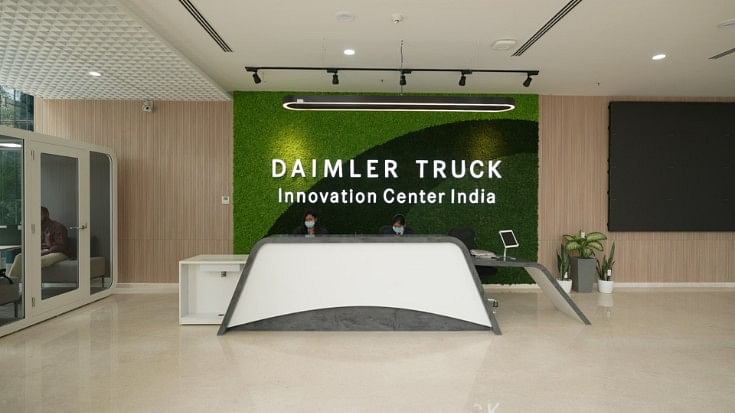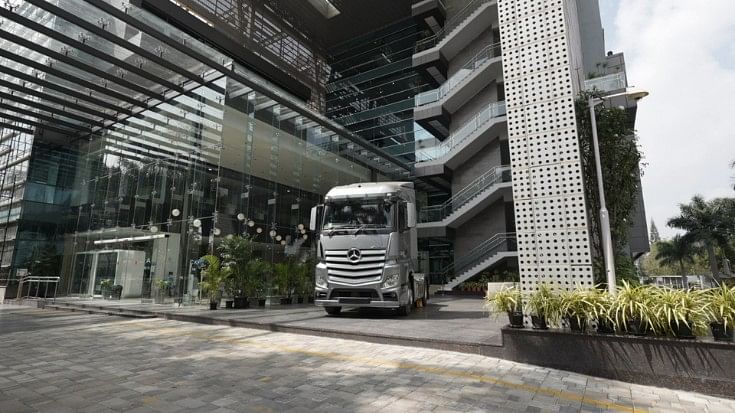Daimler’s innovation centre thinks big on software, emission
Bengaluru-based centre will focus on software-led innovation and zero-emission projects for the company’s BharatBenz and other global truck brands.
In December 2021, Daimler Trucks inaugurated its innovation and development centre for CVs, the Daimler Truck Innovation Center India (DTICI) which will be spearhead the innovation activities of the Group in terms of software-led development, technology and connectivity.
The Bengaluru-based centre will serve as the hub for the technology-related developments for Daimler Truck globally including its brands such as Mercedes-Benz, Freightliner, Western Star, Thomas Built Buses, Fuso, Bharat Benz, and EvoBus GmbH.
Speaking to Autocar Professional, Raghavendra Vaidya, managing director and CEO, Daimler Truck Innovation Center elaborated,” The Centre will be at the leading edge of how we grow and take our products to the next level of innovation, reducing development cycle times and much more.”
The India-based innovation centre will be at the heart of group’s entire innovation activities and aim to push “our boundaries on software-led innovation and zero-emission projects”, the two focus areas of the Daimler group”. At hand to inaugurate the innovation centre was Thomas Ulm, Chairman, Daimler Truck Innovation Center India, who said, “Disruptive automotive technologies and high-quality next generation vehicles will be paramount for companies to create a differentiation in the industry. With the launch of DTICI, we will be able to empower our teams in the CV segment to stay ahead of the curve.”
Holding structure
Daimler Truck Holding AG (“Daimler Truck”) was spun off as an independent identity in 2021 following the group’s decision to separate the luxury cars and CV businesses. As Vaidya puts it, “It was decided to have independent companies – one with a focus on luxury passenger cars and vans, and the other on trucks, buses and associated financial services.”
The next logical step, therefore, was to have a dedicated engineering centre focussed on the product innovation for Daimler’s trucks and buses. The choice of Bengaluru was because of the city’s IT and software prowess as well as the access it would give to talent that the innovation centre would need for its activities. The talent in the city, says Vaidya is phenomenal. He then clarifies that the “low-cost parameter” was not a consideration to locate the innovation centre in India. It’s the talent alone that motivated the decision, he reiterates. Daimler has its Mercedes Benz Research and Development India in Bangalore.
In a nutshell, the innovation centre’s focus areas will be research, product engineering and IT capabilities that underpin all of Daimler Trucks’ activities. The mandate of the engineering team includes vehicle engineering, powertrain engineering, software development for ECUs, CAD/CAE and IT programming.
Equipped with state-of-the-art software tools and labs, this centre will also work on connectivity, cybersecurity, Big Data and advanced analytics, system integration and electrification topics. These are the cutting-edge areas of Industry 4.0. The innovation centre will also have design teams that will work on the interiors and exteriors of the extensive range of trucks and buses.
According to Vaidya, the thinking and deliberations began over three months ago on strategies, goals and objectives for the Centre. He reiterates that with the focus now clear and defined, the innovation centre is all set to kick off its activities. It will have individual teams working on projects end-to-end, Vaidya says, characterising the innovation to be done here as “sheet metal to software”.

DTICI will be a melting pot of all the engineering across the brand and across the globe.
Focus areas
The innovation centre will also focus on connectivity which as Vaidya describes it “ is important for any automotive company”. With connectivity, he explains, vehicles can be connected to the cloud for real time and this includes real-time data exchange. That entire responsibility to drive the strategy and execute on how Daimler Trucks connect vehicles for all our programs in Asia, Europe and USA will be driven from India. “There will also be capability additions within other vehicle software like active safety, ADAS, body control and so on,” the CEO said. Software-led innovation will also emphasise truck safety and reducing the total cost of ownership. Elaborating on the zero emission, Vaidya said the objectives will be battery-driven and hydrogen fuel cell vehicles.
With regard to the human talent, Vaidya said that the Centre will leverage a very talented pool of mechanical, electrical engineers. Its software capabilities will be geared towards zero emission and connectivity. Using an analogy from global cities, he says the innovation centre will verily be a “ melting pot of all the engineering across the brand and across the globe” That translates into leveraging ideas from a “ brand in Europe that we could use it in North America, for example”. Also, the Centre’s unique position as a truck engineering team where engineers work across all the programs, and across the brands gives it the heft to drive innovation.”
On the manufacturing front, Daimler India Commercial Vehicle or DICV has a manufacturing plant at Oragadam near Chennai from which it rolls out the variety of brands that includes Fuso, Mercedes-Benz and Freightliner. From here, products and parts are exported to more than 50 markets in Africa, Asia, Latin America and the Middle East.
With its manufacturing footprint in Chennai and R&D in Bengaluru, Vaidya stresses that the innovation centre is an separate entity and has no linkages with the MBRDI. “We have our own capabilities which include those across the USA, Europe, Asia and China. And on China, he adds that it is a up-and-coming market and outside the home location, India is the largest innovation centre.
Global ownership

The Centre will leverage a very talented pool of mechanical, electrical engineers.
The roadmap for the innovation centre is clear. “We did inherit some capabilities and are now in expansion mode. We intend to add a lot more capabilities and different domains around vehicle software. The Centre will take complete global ownership of many critical components of vehicle software and we are starting with connectivity,” he added.
The innovation centre has a staff strength of around 1400 and plans are afoot to enhance the numbers. As Vaidya says, “We will build the capabilities aligned to Daimler’s global strategy. Fleshing out those capabilities, he says are “advanced analytics, data science, engineering applications and how we can harness data,” he said. The centre has also begun a programme to upskill engineers in Daimler way of engineering products.
With this India footprint, and global linkages, DTICI will give India’s engineering talent the opportunity to work on cutting edge technologies. They will use machine learning algorithms both on engineering and product data and work in active safety, ADAS and more.
On the way work happens in R&D, Vaidya says, “We take steps every day to have less and less prototypes and more work done on the computer. A lot has been achieved in recent decades. It is no secret that prototypes are time-consuming and costly. So, simulation might not replace prototyping but make it much easier. With CAE, we can design and simulate even before prototypes,” he added.
With the new centre working on newer energy options like electric vehicles and hydrogen fuel cells, will it be a viable option in India? Vaidya admits that there are challenges ahead adding that the vehicles themselves have to have the right safety credentials and power requirements. Compliance with government regulations has to be kept in mind. But the future will see progress on different fronts, and a step-by-step process towards those goals, he adds.
The feature was first published in Autocar Professional's April 1, 2022 issue.
RELATED ARTICLES
Tata Motors: From Ice Legacy To Electric Intelligence
Tata Motors has a lot riding on the newly launched Harrier EV, coming as it does on a fresh, EV-oriented software platfo...
Complete List of Cars and SUVs Tested by Bharat NCAP
Bharat NCAP has crash-tested 20 models to date, including both ICE-powered vehicles and EVs.
Belrise Industries: A Story of Grit and Focus
The Belrise Industries IPO is the culmination of a multi-decade journey by entrepreneur Shrikant Badve that started in a...





 01 Apr 2022
01 Apr 2022
 19239 Views
19239 Views





 Ketan Thakkar
Ketan Thakkar



 Shahkar Abidi
Shahkar Abidi

